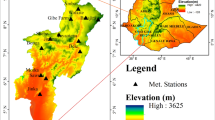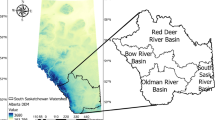Abstract
Drought phenomena are attributed to water availability deficit that is caused by low precipitation. However, droughts are quite complex and cannot simply be defined on the basis of precipitation as other factors may have an influence. In this study, we investigated the spatio-temporal patterns of droughts in Lake Chilwa Basin, an endorheic lake basin that has recently experienced major recurrent lake recessions. The standardized precipitation index (SPI) and standardized precipitation evapotranspiration index (SPEI) at 6- and 12-month timescales were used to evaluate drought severity variations from 1970 to 2018, in relation to the recessions. The stationarity difference in rainfall between 1973 to 1995 and 1996 to 2018 and climatological trends were tested using Mann-Whitney and Mann-Kendall tests, respectively. The El Niño Southern Oscilation (ENSO) influence on rainfall was also investigated. In general, the results show a statistically insignificant decreasing rainfall trend, coupled with statistically significant temperature increase (α=0.05). In addition, both indices broadly detected droughts within similar category ranges and variation patterns, suggesting minimal influence of temperature on droughts compared to rainfall. The study also reveals that not every ENSO event leads to low rainfall in the basin. It is further shown that unlike past major recessions, e.g., 1994/95, recent lake dry-ups of 2012 and 2015 were as a result of milder droughts. Moreover, the trigger threshold of lake dry-ups is shown to have shifted; such that average annual rainfall below 1000mm is likely to yield a dry-up in recent times than before, which may be attributable to anthropogenic pressure.









Similar content being viewed by others
References
Abramowitz M, Stegun I (1965) Handbook of Mathematical Functions with Formulas, Graphs and Mathematical Tables, vol 55. Dover Publictions, NewYork
Agnew S, Chipeta C (1979) Fishing and fish trading : Socio-economic studies. In: Halk M, McLachlan A, Howard-Williams C (eds) Lake Chilwa. Hague, pp 434–468
Anderson M, Hain C, Wardlow B, Pimstein A, Mecikalski J, Kustas W (2011) Evaluation of drought indices based on thermal remote sensing of evapotranspiration over the continental United States. J Clim 24:2025–2044
Beguería S, Vicente-Serrano S, Reig F, Latorre B (2014) Standardized precipitation evapotranspiration index ( SPEI ) revisited : parameter fitting , evapotranspiration models , tools , datasets and drought monitoring. Int J Climatol 34:3001–3023
Byun H, Kim D (2010) Comparing the effective drought index and the standardized precipitation index. Options Méditérr:85–89
Byun H, Wilhite D (1999) Objective quantification of drought severity and duration. Am Meteorol Soc 1980:2747–2756
Chavula, G. M. S. The evaluation of the present and potential water resources management for the lake Chilwa Basin, broadening access and input market systems (2000).
Chiotha S, Likongwe PJ, Sagona W, Mphepo GY, Likoswe M, Tsirizeni MD et al (2017) In: Chiotha S (ed) Lake Chilwa Basin Climate Change Adaptation Program: Impact 2010 - 2017. Lead SEA Publication, Zomba
Clay E, Bohn L, Blanco de Armas E, Kabambe S, Tchale H (2003) Malawi and Southern Africa, Climate Variability and Economic Performance, Washington DC
Dai A (2011) Characteristics and trends in various forms of the Palmer Drought Severity Index during 1900-2008. J Geophys Res 116:1–26
Dubrovsky M, Svoboda MD, Hayes MJ, Wilhite DA, Zalud Z, Hlavinka P (2009) Application of relative drought indices in assessing climate-change impacts on drought conditions in Czechia. Theor Appl Climatol 96:155–171
Guttman NB (1998) Comparing the palmer drought index and the standardised precipitation index. Am Water Resourc Assoc 34(1):113–121
Hao Z, Aghakouchak A (2013) Authors Multivariate Standardized Drought Index: a parametric multi-index model. Adv Water Resour 57:12–18
IPCC (2007) Climate change 2007. In: Regional Climate Projections. Cambridge University Press, Cambridge
Kendall MG (1975) Rank Correlation Methods. Griffin, London
Kirono DGC, Kent DM (2011) Assessment of rainfall and potential evaporation from global climate models and its implications for Australian regional drought projection. Int J Climatol 31:1295–1308
Lancaster N (1979) The changes in the lake level. In: Margaret H, McLachlan H, Howard-Williams C (eds) Lake Chilwa studies of change in a tropical ecosystem (pp. 1–58). The Hague, Boston - London
Leng G, Tang Q, Rayburg S (2015) Climate change impacts on meteorological , agricultural and hydrological droughts in China. Glob Planet Chang 126:23–34
Van Loon AF (2015) Hydrological drought explained. WIREs Water
Malawi, G. of (2018) Malawi Population and Housing Census. Report, Main
Mann HB (1945) Nonparametric Tests Against Trend. Econometrica 13:245
McKee, T. B., Doesken, N. J., & Kleist, J. (1993). The relationship of drought frequency and duration to time scales. In Eight Conference on Applied Climatology (pp. 17–22). Collorado: Fort Collins, Co 80523.
Mcsweeney C, Office M, Lizcano G (2008) The UNDP Climate Change Country Profiles. https://doi.org/10.1175/2009BAMS2826.1
Mvula P, Kalindekafe M, Kishindo P (2014) Fragment management of the Lake chilwa Basin. In: Mvula P, Kalindekafe M, Kishindo M, Berge E, Njaya F (eds) Towards Defragmenting the Management System of Lake Chilwa Basin , Malawi, 1st edn. RSA, Capetown, pp 9–14
Ngongondo C, Xu C-Y, Gottschalk L (2011a) Alemaw, B. (2011). Evaluation of spatial and temporal characteristics of rainfall in Malawi: a case of data scarce region. Theor Appl Climatol 106:79–93. https://doi.org/10.1007/s00704-011-0413-0
Ngongondo CS, Lena CX, Alemaw B, Chirwa T (2011b) Regional frequency analysis of rainfall extremes in Southern Malawi using the index rainfall and L-moments approaches. Stoch Env Res Risk A 25:939–955
Ngongondo C, Xu C, Tallaksen LM, Alemaw B (2015) Observed and simulated changes in the water balance components over Malawi , during 1971 e 2000. Quat Int 369:7–16
Nicholson SE, Klotter D, Chavula G (2014) A detailed rainfall climatology for Malawi , Southern Africa. Int J Climatol 34:315–325
Njaya FJ (2001) Review of management measures for Lake Chilwa, Malawi. UNU-Fisheries Training Programme, Reykjavic
Njaya FJ (2009) Governance of Lake Chilwa common pool resources: evolution and conflicts Governance of Lake Chilwa common pool resources: evolution and conflicts. Dev South Afr 26(4):663–676
Palmer, W. (1965). Meteorological drought. Washington DC, U.S.
Peel MC, Finlayson BL, Mcmahon T (2007) Updated World Map of the Koppen-Geiger Climate Classification. Hydrol Earth Syst Sci 11:1633–1644
Rebelo L, Mccartney MP, Finlayson MC (2011) The application of geospatial analyses to support an integrated study into the ecological character and sustainable use of Lake Chilwa. J Great Lakes Res 37:83–92
Sankarasubramanian A, Srinivasan K (1999) Investigation and comparison of sampling properties of L-moments and conventional moments. J Hydrol 218:13–34
Sheffield J, Andreadis K, Wood E, Lettenmaier E (2009) Global and continental drought in the second half of the twentieth century : severity – area – duration analysis and temporal variability of large-scale events. Am Meteorol Soc 22:1962–1981
Shongwe M, Van Oldenborgh G, Van Der Hurk B (2009) Projected changes in mean and extreme precipitation in Africa under global warming. Part I : Southern Africa. J Clim 22:3819–3838
Thornthwaite, C. (1948). An approach toward a Rational Classification of Climate (Vol. 38).
Vicente-Serrano S, Begueria S, López-Moreno J (2010) A multiscalar drought index sensitive to global warming: the standardized precipitation evapotranspiration index. J Clim 23:1696–1718
Vicente-serrano, S. M. (2007). Evaluating the impact of drought using remote sensing in a Mediterranean, semi-arid region, 173–208.
Vicente-serrano SM, Gouveia C, Julio J, Beguería S, Trigo R (2013) Response of vegetation to drought time-scales across global land biomes. PNAS 110(1):52–57
Wambua R, Mutua B, Raude J (2018) Detection of spatial, temporal and trend of meteorological drought using standardized precipitation index (SPI) and effective drought index (EDI) in the Upper Tana River Basin, Kenya. Open J Modern Hydrol 08(03):83–100
Wang B, Luo X, Yang Y, Sun W, Cane MA, Cai W, Yeh S (2019) Historical change of El Niño properties sheds light on future changes of extreme El Niño. Proc Natl Acad Sci 116(45):22512–22517
Wang Q, Shi P, Lei T, Geng G, Liu J, Mo X (2015) The alleviating trend of drought in the Huang-Huai-Hai Plain of China based on the daily SPEI. Int J Climatol 35:3760–3769
Wilhite DA (2000) Drought as a natural hazard: concepts and definitions drought as a natural hazard: concepts and definitions. Drought Mitigation Center Faculty Publications, University of Nebraska - Lincoln, London, pp 3–18
WMO. (1988). Analysing long time-series of hydrological data with respect to climate variability. WCAP-3, WMO/TD No.224, p 12.
Zhang A, Jia G (2013) Remote sensing of environment monitoring meteorological drought in semiarid regions using multi-sensor microwave remote sensing data. Remote Sens Environ 134:12–23
Zuzani PN, Ngongondo CS, Mwale FD, Willems P (2019) Examining trends of hydro-meteorological extremes in the Shire River Basin in Malawi. Phys Chem Earth 2(7):1–13
Acknowledgements
We further acknowledge the Malawi Department of Climate Change and Meteorological Services (DCCMS) for kindly providing the climate data.
Data, material, and code availability
Meteorological data used for this study can be accessed through the link provided below. Additional data, material or code used can be provided upon request to the authors if needed, https://drive.google.com/drive/folders/1kUSuzJ1dXpoTtDc_6sCBw3Gaw73oYIcK?usp=sharing.
Funding
This work was financially supported by the project ‘Building REsearch Capacity for sustainable water and food security In dry lands of Sub-Saharan Africa’ (BRECcIA) which is supported by UK Research and Innovation as part of the Global Challenges Research Fund, grant number NE/P021093/1.
Author information
Authors and Affiliations
Contributions
O. Kambombe took lead of the research, analyzed, did literature review, and drafted the initial manuscript.
C. Ngongondo took lead in the supervision, guided research direction, and assisted in the writing and editing of the manuscript.
L. Eneya contributed in the supervision, provided research direction, and assisted in the writing and editing of the manuscript.
M. Monjerezi contributed in the supervision, provided research direction, and assisted in the writing and editing of the manuscript.
C. Boyce provided most of the meteorological data used for the study and assisted in the writing and editing of the manuscript.
The listed authors have made a significant contribution to warrant their being part of authorship and have approved the work.
Corresponding author
Ethics declarations
Ethics approval
The study followed all necessary ethical and professional conduct. Since no human or animal subjects were involved, a special waiver was provided by the university to go ahead with the study.
Consent to participate
No human subjects were involved and hence consent to participate was not applicable.
Consent for publication
The authors affirm that all the relevant data provided for this research was consented for publication.
Conflict of interest
There are no any direct or indirect conflicts of interest that we are aware of regarding this work.
Additional information
Publisher’s note
Springer Nature remains neutral with regard to jurisdictional claims in published maps and institutional affiliations.
Rights and permissions
About this article
Cite this article
Kambombe, O., Ngongondo, C., Eneya, L. et al. Spatio-temporal analysis of droughts in the Lake Chilwa Basin, Malawi. Theor Appl Climatol 144, 1219–1231 (2021). https://doi.org/10.1007/s00704-021-03586-0
Received:
Accepted:
Published:
Issue Date:
DOI: https://doi.org/10.1007/s00704-021-03586-0




